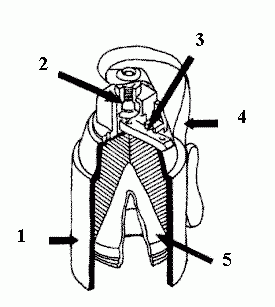- the fuse;
- the head end assembly;
- M77 cumulative shrapnel warheads;
- cylindrical polyurethane unit;
- fuse;
- nozzle;
- stabilizer unit blade;
- rocket engine;
- supercalibre nozzles.
The M26 projectile is designed to defeat open-mounted manpower and military equipment, light armored combat vehicles, as well as for counter-battery combat.
The M26 is the first major unmanned rocket projectile in the MLRS system with the M270 combat vehicle. It consists of the main and missile parts. The cassette head unit (see layout diagram) is equipped with 644 M77 shaped-shrapnel warheads (see photo). The combat elements are tightly packed in sockets of cylindrical polyurethane blocks inside a thin-walled aluminium housing. After the head detonator is triggered at the end of the trajectory, the HC housing is discarded and the combat elements are scattered. A single launcher salvo disperses 7,728 such elements over an area of approximately 25,000 square metres.
- steel case;
- M223 fuse;
- explosive substance;
- belt brake;
- cumulative funnel;
Detonation of an M77 combat unit occurs when it meets an obstacle. The possibility of hitting the equipment is provided by a cumulative jet with a built-in rigidity element. Armour penetration is up to four inches (up to 101.6 mm). Fragments from the crushing of the steel case provide an impact on live force within a radius of 4 meters. The failure rate of the fuse element is about 4 percent.
The M26 was first tested in combat conditions in 1991 during Operation Desert Storm. As disadvantages of the MLRS system, the relatively short range of the M26 and the fact that the M77 combat elements proved to be practically ineffective against armored targets were noted by the combat participants.
M26 was adopted by the armies of 14 states. At present, the projectile is no longer in production and has been removed from service.
In 1995, after comments from army specialists, a program was launched to develop the ER-MLRS projectile with extended range and an improved cumulated-shrapnel warhead for its equipment.
Tactical and technical characteristics
| Caliber, mm | 227 |
| Length, mm | 3937 |
| Missile range, km | 31,6 |
| Weight, kg: - total - launch - header - rocket engine |
306 307 154 about 148 |
| Header type | cassette |
| Number of combat elements | 644 COBE M77 |
| Head opening height, m. | about 762 |
| Battle unit diameter, mm | 38 |
| Combat unit height, mm | 81 |
| Armor penetration by cumulative jet, mm | 76–102 |
| Square of defeat: - war machine volley, m2 - head end, m |
25000 200х100 |
| The length of the rocket engine, mm | 1977 |
| Period of storage, years. | 18 (10) |

